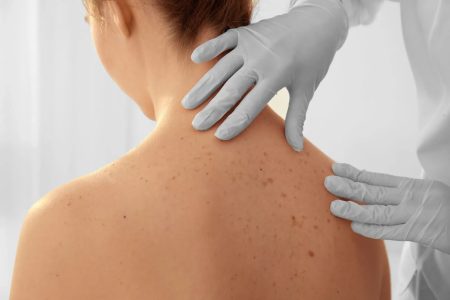What is Mohs micrographic surgery?
Mohs micrographic surgery is a precise form of surgery to remove certain skin cancers. Also known as Mohs surgery, it is named after the doctor who came up with it. During Mohs surgery, thin layers of cancer-containing skin are removed in stages until only cancer-free skin remains. The aim of Mohs surgery is to remove all the skin cancer while minimising the removal and damage to surrounding healthy tissue.
Why did the doctor offer me Mohs surgery?
Mohs surgery is used to treat most common skin cancers, such as basal cell carcinoma and squamous cell carcinoma, as well as some other skin cancers. Your doctor may have recommended Mohs surgery for the following reasons
- Tumour has returned or has a high risk of returning
- Tumour was removed incompletely
- Tumour is located in a location where you want to preserve as much healthy skin as possible, such as the eyelid, nose, ear or lip
- The tumour edge is not well defined or large in size
- The aggressive type of tumour
Why should I have Mohs surgery?
Mohs surgery increases the chance of cure and reduces the need for additional surgery or treatments. The ability to ‘see where the cancer is going’ gives Mohs surgery these important advantages.
- Mohs surgery has a high cure rate
- Mohs surgery allows you to keep as much healthy skin as possible because the surgeon only removes the skin with cancer cells. This is especially important when skin cancer develops in an area with little tissue beneath (e.g. eyelid, ear or lip)
What happens during Mohs surgery?
The surgery is carried out under local anaesthesia. This anaesthetic only numbs the area of surgery and you will remain awake. If you are very anxious, we can give you a mild sedative. Your surgeon will first remove the visible tumour followed by a thin margin of the surrounding skin. You are then bandaged so that you can wait in comfort in the waiting area. This tissue is then examined under a microscope while you are still in the clinic. If it contains cancer cells, another layer of tissue is removed and examined. Further layers of tissue that contain cancerous cells are removed, one layer at a time until all the cancer cells have been removed. The local anaesthetic lasts for about 2 hours and can be topped up if needed.
After the tumour has been removed, there are several options for repairing the wound. These will be discussed with you before your surgery. Some options include
- Reconstruction and closure by the Mohs surgeon
- Dressed and then repaired by a plastic surgeon
- Leaving to heal on its own
How can I prepare for my surgery?
- Do cut down or stop smoking as many days before your Mohs surgery as possible. It is also important to cut down on smoking for at least 1 month after your surgery.
One week before surgery
- Do check if you need to stop any of your regular medication or supplements.
On the day of the surgery
- Do shower and wash your hair before the surgery.
- Do have your breakfast before coming down.
- Do take your regular medication, especially hypertension (high blood pressure) medication before coming down to the clinic. If you have been instructed to stop the certain medications, please do so.
- Do get a close relative or friend to accompany you if you are feeling especially anxious.
- Don’t put on makeup or jewellery.
- Don’t drive to the clinic.





